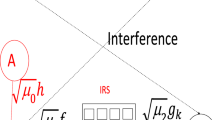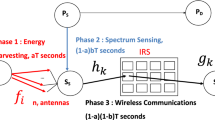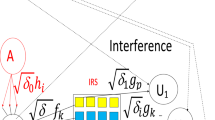Abstract
In this paper, we derive the throughput of cognitive radio networks (CRN) where the secondary source \(S_S\) harvests energy and adapts its power to generate an interference at primary destination \(P_D\) less than T. \(S_S\) transmits a linear combination of symbols to K nonorthogonal multiple access (NOMA) users. Intelligent reflecting surfaces (IRS) are placed between the secondary source and NOMA users. A set \(I_i\) of reflectors of IRS is dedicated to user \(U_i\) so that all reflections are in phase at \(U_i\). We derive the throughput at each user and the total throughput when IRS are used in CRN-NOMA. We optimize the NOMA powers as well as the harvesting duration \(\alpha \). When \(N_i=8,32\) reflectors per user are employed, we obtain 24 and 41 dB gain with respect to CRN-NOMA with adaptive transmit power, energy harvesting and without IRS.
Similar content being viewed by others
Avoid common mistakes on your manuscript.
1 Introduction
Intelligent reflecting surfaces (IRS) improve the throughput of wireless systems as all reflections are in phase at the destination [1,2,3,4,5]. The phase shift of kth reflector depends on the phase of channel gain between the source and kth IRS reflector as well as the phase of channel gain between IRS and destination [6,7,8]. IRS for NOMA systems and fixed transmit power was recently analyzed in [9]. A set \(I_i\) of reflectors are dedicated to user \(U_i\) so that all reflections are in phase at \(U_i\). In [9], there is a single network without energy harvesting and the results cannot be applied to CRN-NOMA where the secondary source harvests energy and transmits with an adaptive transmit power. IRS have been deployed to enhance the throughput of millimeter wave communications [10, 11] as well as optical communications [12]. IRS with finite phase shifts were suggested in [13]. Asymptotic performance analysis of wireless networks using IRS was discussed in [14]. When the number of reflectors is doubled, a 6 dB enhancement in throughput was observed in [1, 15, 16]. Antenna design, prototyping and experimental results of IRS were provided in [17]. Deep and machine learning algorithms were applied to wireless networks equipped with IRS [18, 19].
In this paper, we suggest the use of IRS for CRN-NOMA where the secondary source \(S_S\) harvests energy from RF received signal from node A. \(S_S\) adapts its transmit power so that the interference at secondary destination is less than T. \(S_S\) transmits a linear combination of K symbols to NOMA users. A set \(I_i\) of IRS reflectors are dedicated to user \(U_i\) so that all reflections are in phase at \(U_i\). We derive and improve the total throughput by optimizing the harvesting process and NOMA powers. When \(N_i=8,32\) reflectors per user are employed, we obtain 24 and 41 dB gain with respect to CRN-NOMA with adaptive transmit power, energy harvesting and without IRS [20, 21]. NOMA for multi-carrier code division multiple access (MC-CDMA) has been recently suggested in [22]. The results of [22] study NOMA for MC-CDMA system with fixed powers and without IRS.
Next section describes the system model. The energy harvesting process is analyzed in Sect. 3. The throughput is derived and optimized in Sect. 4. Section 5 gives the numerical results while last section concludes the paper and suggests some perspectives.
2 System model
Figure 1 depicts the system model containing a secondary source \(S_S\) transmitting a signal to K NOMA secondary users \(U_1\), \(U_2,\ldots ,U_K\). \(S_S\) harvests energy using the received signal from node A. Then, \(S_S\) transmits a combination of K symbols to K NOMA users using an adaptive transmit power so that the generated interference at secondary destination \(S_D\) is less than threshold T. We make the analysis in the presence and absence of primary interference from primary source \(P_S\) to all users \(U_i\), \(i=1,2,\ldots ,K\).
3 Energy harvesting model
The harvested energy at \(S_S\) is equal to [20]
where F is frame duration, \(0<\alpha <1\) is harvesting duration, \(P_A\) is the power of node A, \(\varepsilon \) is the efficiency of energy conversion and \(\sqrt{\mu _0} h\) is channel gain between A and \(S_S\) and \(\mu _0\) is the average power of \(\sqrt{\mu _0}h\).
The available symbol energy of \(S_S\) is written as
where
where \(E_A=P_AT_s\).
The adaptive symbol energy of \(S_S\) is expressed as
where \(h_{S_SP_D}\) is the channel gain between \(S_S\) and \(P_D\). The generate interference at \(P_D\) is less than T: \(E_s |h_{S_SP_D}|^2\le T\).
The CDF of \(E_s\) is given by
We deduce
where \(\rho _{S_SP_D}=E(|h_{S_SP_D}|^2)\) and E(.) is the expectation operator.
4 SINR and throughput analysis
4.1 Received signal model
In Fig. 1, the users are ranked as follows: \(U_1\) is the strongest user, \(U_i\) is the ith strong user and \(U_K\) is the weakest user. The transmitted NOMA symbol by \(S_S\) is equal to
\(s_i\) is the symbol of user \(U_i\) and \(0<P_i<1\) is the power allocated to \(U_i\) such that \(0<P_1<P_2<..<P_K<1\) and \(\sum _{i=1}^KP_i=1.\)
As shown in Fig. 1, let \(\sqrt{\mu }f_k\) be the channel coefficient between \(S_S\) and kth reflector of IRS where \(\mu =\frac{1}{D^{ple}}=E(|\sqrt{\mu }f_k|^2)\), ple is the path loss exponent and D is the distance between \(S_S\) and IRS. Let \(\sqrt{\mu _i}g_k\) be the channel coefficient between kth reflector of IRS and user \(U_i\) where \(\mu _i=\frac{1}{D_i^{ple}}=E(|\sqrt{\mu _i}g_k|^2)\) and \(D_i\) is the distance between IRS and \(U_i\). The received signal at user \(U_i\) is written as
where \(I_i\) is the set of reflectors dedicated to user \(U_i\) and n is a Gaussian noise with variance \(N_0\).
\(\theta _k\) is the phase shift of kth reflector given by [1]
where \(b_k\), \(d_k\) are the phase of \(f_k=a_ke^{-jb_k}\) and \(g_k=c_ke^{-jd_k}\), \(a_k=|f_k|\) and \(c_k=|g_k|\).
where
We define
Therefore, the received signal at \(U_i\) can be written as
where
4.2 SINR analysis
\(U_i\) performs successive interference cancelation (SIC) and detects first \(s_K\) since \(P_K>P_i, \forall i \ne K\). The corresponding SINR is
The contribution of the detected symbol \(s_K\) is removed and \(U_i\) detects \(s_{K-1}\) with SINR
The process is continued by detecting \(s_l\) for \(l=K,K-1,\ldots ,i\) with SINR
There is no outage at \(U_i\) if all SINR \(\varGamma ^{i\rightarrow l}\) are larger than threshold x for \(l=K,K-1,\ldots ,i\):
where \(P_{Y_i}(y)\) is the CDF of \(Y_i\) provided Sect. 4.4.
The packet error probability (PEP) at \(U_i\) is deduced from the outage probability as follows [23]
where [23]
pl is packet length and SEP(x) is the symbol error probability (SEP) of Q-QAM [24]
The throughput at \(U_i\) is computed as
The total throughput of NOMA network is equal to
We propose to optimize numerically the power allocated (OPA) to NOMA users as well as the harvesting duration \(\alpha \) to maximize the total throughput (23):
under constraint \(\sum _{l=1}^KP_l=1\).
4.3 Effects of primary interference
In the presence of interference from primary source \(P_S\), the SINR at user \(U_i\) to detect \(s_l\) \(l=K,K-1,\ldots ,i\) becomes
where \(I_i=E_{P_S}|h_{P_SU_i}|^2\) is the interference at \(U_i\) due to the signal of \(P_S\), \(E_{P_S}\) is the transmitted energy per symbol of \(P_S\) and \(h_{P_SU_i}\) is the channel gain between \(P_S\) and \(U_i\). For Rayleigh channels, \(I_i\) has an exponential distribution written as
where \(\overline{I_i}=E(I_i)\) is the average interference at \(U_i\).
The outage probability at \(U_i\) becomes
The PEP and throughput are evaluated using Eqs. (19–23).
4.4 CDF of \(Y_i\)
Let \(N_i=|I_i|\) be the number of reflectors dedicated to \(U_i\). For \(N_i\ge 8\), \(A_i\) follows a Gaussian distribution with variance \(\sigma _{A_i}^2=N_i(1-\frac{\pi ^2}{16})\) and mean \(m_{A_i}=E(A_i)=\frac{N_i\pi }{4}\).
We have
The cumulative distribution function (CDF) of \(X_i\) is equal to
where
By a derivative, the probability density function (PDF) of \(X_i\) is given by
The CDF of \(Y_i=E_sX_i\) is evaluated as
where \(P_{E_s}(x)\) is given in (6) and \(p_{X_i}(x)\) is provided in (31).
5 Numerical results
Figures 2 and 3 show the PEP at strong and weak users for \(P_A=1\), \(\mu _0=1\), \(\varepsilon =0.5\), \(K=2\), \(D=1.5\), \(D_1=1\), \(D_2=1.5\), \(P_1=0.3\), \(P_2=0.7\), \(ple=3\), \(pl=300\) and harvesting duration \(\alpha =0.5\). The interference threshold is \(T=1\), the distance between \(S_S\) and \(P_D\) is 1.5 and the distance between primary source and users \(U_1\) and \(U_2\) are 2 and 2.5. These results correspond to 16 QAM modulation. The number of reflectors per user is \(N_1=N_2=8,16,32\). We observe that the PEP decreases as the number of reflectors per user \(N_1\) and \(N_2\) increases.
Figures 4 and 5 depict the throughput at strong and weak users for the same parameters as Figs. 2 and 3. We notice that the throughput increases as the number of reflectors increases \(N_1=N_2=8,16,32\). Besides, the simulation results are close to theoretical derivations (22). Figure 6 depicts the total throughput as the sum of throughput of strong and weak users. Harvesting duration optimization allows significant throughput enhancement.
Figure 7 depicts the total throughput in the presence of \(K=3\) NOMA users for \(D_1=1\), \(D_2=1.5\), \(D_3=1.8\). The allocated powers are \(P_1=0.2\), \(P_2=0.3\) and \(P_3=0.5\). The distances between \(P_S\) and users \(U_1\), \(U_2\) and \(U_3\) are 2, 2.5 and 3. The other parameters are the same as Figs. 2 and 3. When the number of reflector per user is \(N_i=32\) we obtained 6,12 dB gain with respect to \(N_i=16,8\). When powers allocated to NOMA users are optimized we obtained up to 5 dB gain with respect to \(P_1=0.2\), \(P_2=0.3\) and \(P_3=0.5\). When harvesting duration \(\alpha \) is optimized as well as the allocated NOMA powers, we obtained the largest throughput.
Figure 8 depicts the throughput of NOMA and orthogonal multiple access (OMA) when IRS are used and without IRS [20, 21]. The parameters are the same as Figs. 2 and 3. When \(N_i=8,32\) reflectors per user are employed, we obtained 24 and 41 dB gain with respect to NOMA with adaptive transmit power, energy harvesting and without IRS [20, 21]. OMA without IRS offers a better throughput than NOMA without IRS at low average SNR per bit. At high average SNR per bit, NOMA without IRS offers a better throughput than OMA without IRS.
Figure 9 shows the effects of interference \(T=1,5\) threshold on secondary throughput for the same parameters as Figs. 2 and 3. The number of reflectors per user is \(N_i=8\). When T increases, \(S_S\) can increase its power since there is less interference constraints and the throughput increases.
6 Conclusion and perspectives
In this paper, we computed the throughput of cognitive radio networks using NOMA and intelligent reflecting surfaces where the secondary source harvests energy from the received RF signal from node A. Besides, the secondary source adapts its power to reduce the generated interference at primary destination. The secondary source transmits a linear combination of K symbols dedicated to K secondary users. The transmitted signal is reflected by a set \(I_i\) of reflectors dedicated to user \(U_i\) so that all reflections are in phase at \(U_i\). When \(N_i=8,32\) reflectors per user are employed, we obtained 24 and 41 dB gain with respect to NOMA with adaptive transmit power, energy harvesting and without IRS [20, 21]. We also optimized NOMA powers and the harvesting duration. As a perspective, we can consider other source of energy such as wind and solar.
References
Basar, E., Di Renzo, M., De Rosny, J., Debbah, M., Alouini, M.-S., Zhang, R.: Wireless Communications Through Reconfigurable Intelligent Surfaces. IEEE Access 7, 2019 (2019)
Zhang, H., Di, B., Song, L., Han, Z.: Reconfigurable intelligent surfaces assisted communications with limited phase shifts: how many phase shifts are enough? IEEE Trans. Veh. Technol. 69(4), 4498–4502 (2020)
Di Renzo, M.: 6G wireless: wireless networks empowered by reconfigurable intelligent surfaces. In: 2019 25th Asia-Pacific Conference on Communications (APCC)
Basar, E.: Reconfigurable intelligent surface-based index modulation: a new beyond MIMO paradigm for 6G. IEEE Trans. Commun. 68, 3187–3196 (2020)
Wu, Q., Zhang, R.: Towards smart and reconfigurable environment: intelligent reflecting surface aided wireless network. IEEE Commun. Mag. 58(1), 106–112 (2020)
Huang, C., Zappone, A., Alexandropoulos, G.C., Debbah, M., Yuen, C.: Reconfigurable intelligent surfaces for energy efficiency in wireless communication. IEEE Trans. Wirel. Commun. 18(8), 4157–4170 (2019)
Alexandropoulos, G.C., Vlachos, E.: A hardware architecture for reconfigurable intelligent surfaces with minimal active elements for explicit channel estimation. In: ICASSP 2020 - 2020 IEEE International Conference on Acoustics, Speech and Signal Processing (ICASSP) (2020)
Guo, H., Liang, Y.-C., Chen, J., Larsson, E.G.: Weighted sum-rate maximization for reconfigurable intelligent surface aided wireless networks. IEEE Trans. Wirel. Commun. 19, 3064–3076 (2020)
Thirumavalavan, V.C., Jayaraman, T.S.: BER analysis of reconfigurable intelligent surface assisted downlink power domain NOMA system. In: 2020 International Conference on COMmunication Systems and NETworkS (COMSNETS) (2020)
Pradhan, C., Li, A., Song, L., Vucetic, B., Li, Y.: Hybrid precoding design for reconfigurable intelligent surface aided mmWave communication systems. IEEE Wirel. Commun. Lett. 9, 1041–1045 (2020)
Ying, K., Gao, Z., Lyu, S., Wu, Y., Wang, H., Alouini, M.-S.: GMD-based hybrid beamforming for large reconfigurable intelligent surface assisted millimeter-wave massive MIMO. IEEE Access 8, 109530–19539 (2020)
Yang, L., Guo, W., Ansari, I.S.: Mixed dual-hop FSO-RF communication systems through reconfigurable intelligent surface. IEEE Commun. Lett. 24, 1558–1562 (2020)
Di, B., Zhang, H., Li, L., Song, L., Li, Y., Han, Z.: Practical hybrid beamforming with finite-resolution phase shifters for reconfigurable intelligent surface based multi-user communications. IEEE Trans. Veh. Technol. 69(4), 4565–4570 (2020)
Nadeem, Q.-A., Kammoun, A., Chaaban, A., Debbah, M., Alouini, M.-S.: Asymptotic max-min SINR analysis of reconfigurable intelligent surface assisted MISO systems. IEEE Trans. Wirel. Commun. 19, 7748–7764 (2020)
Zhao, W., Wang, G., Atapattu, S., Tsiftsis, T.A., Tellambura, C.: Is backscatter link stronger than direct link in reconfigurable intelligent surface-assisted system? IEEE Commun. Lett. 24, 1342–1346 (2020)
Li, S., Duo, B., Yuan, X., Liang, Y.-C., Di Renzo, M.: Reconfigurable intelligent surface assisted UAV communication: joint trajectory design and passive beamforming. IEEE Wirel. Commun. Lett. 9, 716–720 (2020)
Dai, L., Wang, B., Wang, M., Yang, X., Tan, J., Bi, S., Xu, S., Yang, F., Chen, Z., Di Renzo, M., Chae, C.-B., Hanzo, L.: Reconfigurable intelligent surface-based wireless communications: antenna design, prototyping, and experimental results. IEEE Access 8, 45913–45923 (2020)
Hua, S., Shi, Y.: Reconfigurable intelligent surface for green edge inference in machine learning. In: 2019 IEEE Globecom Workshops (GC Wkshps) (2019)
Huang, C., Alexandropoulos, G.C., Yuen, C., Debbah, M.: Indoor signal focusing with deep learning designed reconfigurable intelligent surfaces. In: 2019 IEEE 20th International Workshop on Signal Processing Advances in Wireless Communications (SPAWC) (2019)
Alhamad, R., Boujemaa, H.: Throughput enhancement of cognitive radio networks-nonorthogonal multiple access with energy harvesting and adaptive transmit power. Trans. Emerg. Telecommun. Technol. 31(8), e3980 (2020)
Alhamad, R., Boujemaa, H.: Optimal power allocation for CRN-NOMA systems with adaptive transmit power. Signal Image Video Process. 14(7), 1327–1334 (2020)
Alhamad, R., Boujemaa, H.: Non orthogonal multiple access for MC-CDMA systems. Signal Image Video Process. (2021, Submitted to)
Xi, Y., Burr, A., Wei, J.B., Grace, D.: A general upper bound to evaluate packet error rate over quasi-static fading channels. IEEE Trans. Wirel. Commun. 10(5), 1373–1377 (2011)
Proakis, J.: Digital Communications, 5th edn. Mac Graw-Hill, New York (2007)
Author information
Authors and Affiliations
Corresponding author
Additional information
Publisher's Note
Springer Nature remains neutral with regard to jurisdictional claims in published maps and institutional affiliations.
Rights and permissions
About this article
Cite this article
Alhamad, R. Nonorthogonal multiple access with adaptive transmit power and energy harvesting using intelligent reflecting surfaces for cognitive radio networks. SIViP 17, 83–89 (2023). https://doi.org/10.1007/s11760-022-02206-2
Received:
Revised:
Accepted:
Published:
Issue Date:
DOI: https://doi.org/10.1007/s11760-022-02206-2













